coolant temperature TOYOTA HIGHLANDER 2018 Owners Manual (in English)
[x] Cancel search | Manufacturer: TOYOTA, Model Year: 2018, Model line: HIGHLANDER, Model: TOYOTA HIGHLANDER 2018Pages: 732, PDF Size: 14.5 MB
Page 92 of 732

922. Instrument cluster
HIGHLANDER_U (OM0E031U)
Tachometer
Displays the engine speed in revolutions per minute.
Multi-information display
Presents the driver with a variety of driving-related data.
Speedometer
Fuel gauge
Trip meter reset knob
Switches the trip information.
Outside temperature
Odometer/trip meter/Stop & Start system operation time display*
Shift position and shift range
Displays the selected shift position or selected shift range. ( P. 227)
Instrument panel light control button
Engine coolant temperature gauge
Displays the engine coolant temperature.
*: If equipped
Gauge and meters
The displayed content may differ depending on the type of
meter.
1
2
3
4
5
6
7
8
9
10
Page 94 of 732

942. Instrument cluster
HIGHLANDER_U (OM0E031U)
NOTICE
■To prevent damage to the engine and its components
● Do not let the indicator needle of the tachometer enter the red zone, which
indicates the maximum engine speed.
● The engine may be overheating if the engine coolant temperature gauge is
in the red zone (H). In this case, immediately stop the vehicle in a safe
place, and check the engine after it has cooled completely. ( P. 644)
Page 212 of 732
![TOYOTA HIGHLANDER 2018 Owners Manual (in English) 2124-1. Before driving
HIGHLANDER_U (OM0E031U)
●Due to the added load of the trailer, your vehicle’s engine may over-
heat on hot days (at temperatures over 85 F [30C]) when drivi TOYOTA HIGHLANDER 2018 Owners Manual (in English) 2124-1. Before driving
HIGHLANDER_U (OM0E031U)
●Due to the added load of the trailer, your vehicle’s engine may over-
heat on hot days (at temperatures over 85 F [30C]) when drivi](/img/14/42541/w960_42541-211.png)
2124-1. Before driving
HIGHLANDER_U (OM0E031U)
●Due to the added load of the trailer, your vehicle’s engine may over-
heat on hot days (at temperatures over 85 F [30C]) when driving
up a long or steep grade. If the engine coolant temperature gau ge
indicates overheating, immediately turn off the air conditionin g (if in
use), pull your vehicle off the road and stop in a safe spot.
( P. 644)
● Always place wheel blocks under both the vehicle’s and the trai ler’s
wheels when parking. Apply the parking brake firmly, and put th e
transmission in P. Avoid parking on a slope, but if unavoidable , do
so only after perform ing the following:
Apply the brakes and keep them applied.
Have someone place wheel blocks under both the vehicle’s and
trailer’s wheels.
When the wheel blocks are in pl ace, release the brakes slowly
until the blocks absorb the load.
Apply the parking brake firmly.
Shift into P and turn off the engine.
● When restarting afte r parking on a slope:
With the transmission in P, start the engine. Be sure to keep t he
brake pedal depressed.
Shift into a forward gear. If reversing, shift into R.
Release the parking brake and brake pedal, and slowly pull or
back away from the wheel bloc ks. Stop and apply the brakes.
Have someone retrieve the blocks.
1
2
3
4
5
1
2
3
4
Page 299 of 732

2994-5. Using the driving support systems
4
Driving
HIGHLANDER_U (OM0E031U)
■Operating conditions
●The Stop & Start system is operational when all of the followin g conditions
are met:
• The brake pedal is being depressed firmly.
• The engine is adequately warmed up.
• The outside temperature is 23°F (-5°C) or higher.
• The shift lever is in D.
• is off.
• The hood is closed.
• The driver's seat belt is fastened.
• The driver's door is closed.
• The accelerator pedal is not being depressed.
● In the following situations the engine may not be stopped by th e Stop & Start
system. This is not a malfunction of the Stop & Start system.
• The air conditioning system is being used when the ambient tem perature
is high or low.
• The battery is not sufficiently charged, such as if the vehicle has been
parked for a long time and the battery charge has decreased, the electric
load is large, the battery temperature is excessively low or th e battery has
deteriorated, or is undergoing a periodic recharge.
• The brake booster vacuum is low.
• The vehicle is stopped on a steep incline.
• The steering wheel is being operated.
• Due to traffic or other circumstances the vehicle is being sto pped repeat-
edly.
• The vehicle is being driven in a high altitude area.
• Engine coolant temperature or transmission fluid temperature i s
extremely low or high.
• The battery fluid temperature is extremely low or high.
• For a while after the battery terminals have been disconnected and
reconnected.
• For a while after the battery replacement.
• Power mode or snow mode is selected.
Page 524 of 732
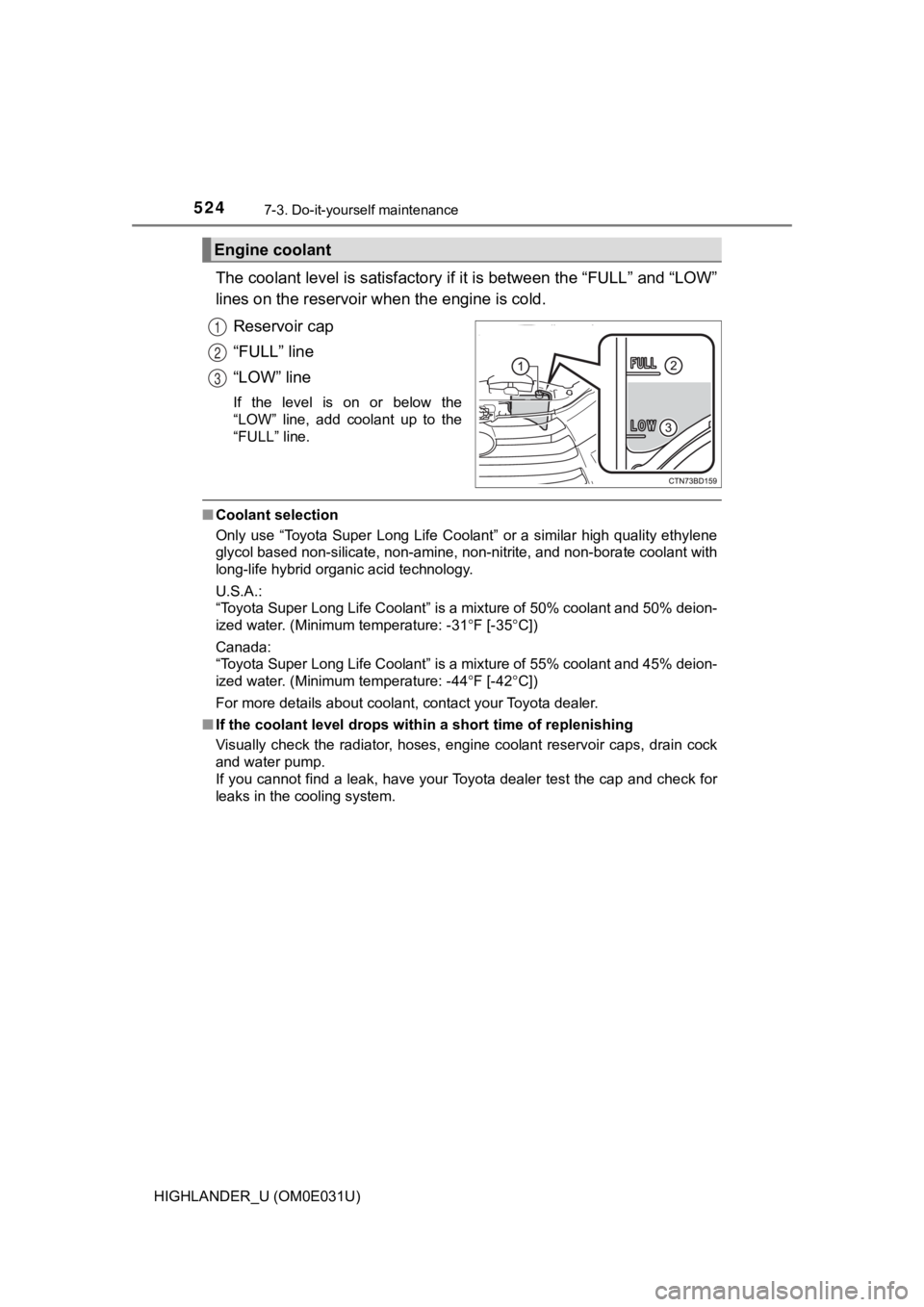
5247-3. Do-it-yourself maintenance
HIGHLANDER_U (OM0E031U)
The coolant level is satisfactory if it is between the “FULL” a nd “LOW”
lines on the reservoir wh en the engine is cold.
Reservoir cap
“FULL” line
“LOW” line
If the level is on or below the
“LOW” line, add coolant up to the
“FULL” line.
■ Coolant selection
Only use “Toyota Super Long Life Coolant” or a similar high quality ethylene
glycol based non-silicate, non-amine, non-nitrite, and non-bora te coolant with
long-life hybrid organic acid technology.
U.S.A.:
“Toyota Super Long Life Coolant” is a mixture of 50% coolant and 50% deion-
ized water. (Minimum temperature: -31 F [-35 C])
Canada:
“Toyota Super Long Life Coolant” is a mixture of 55% coolant and 45% deion-
ized water. (Minimum temperature: -44 F [-42 C])
For more details about coolant, contact your Toyota dealer.
■ If the coolant level drops within a short time of replenishing
Visually check the radiator, hoses, engine coolant reservoir ca ps, drain cock
and water pump.
If you cannot find a leak, have your Toyota dealer test the cap and check for
leaks in the cooling system.
Engine coolant
1
2
3
Page 579 of 732
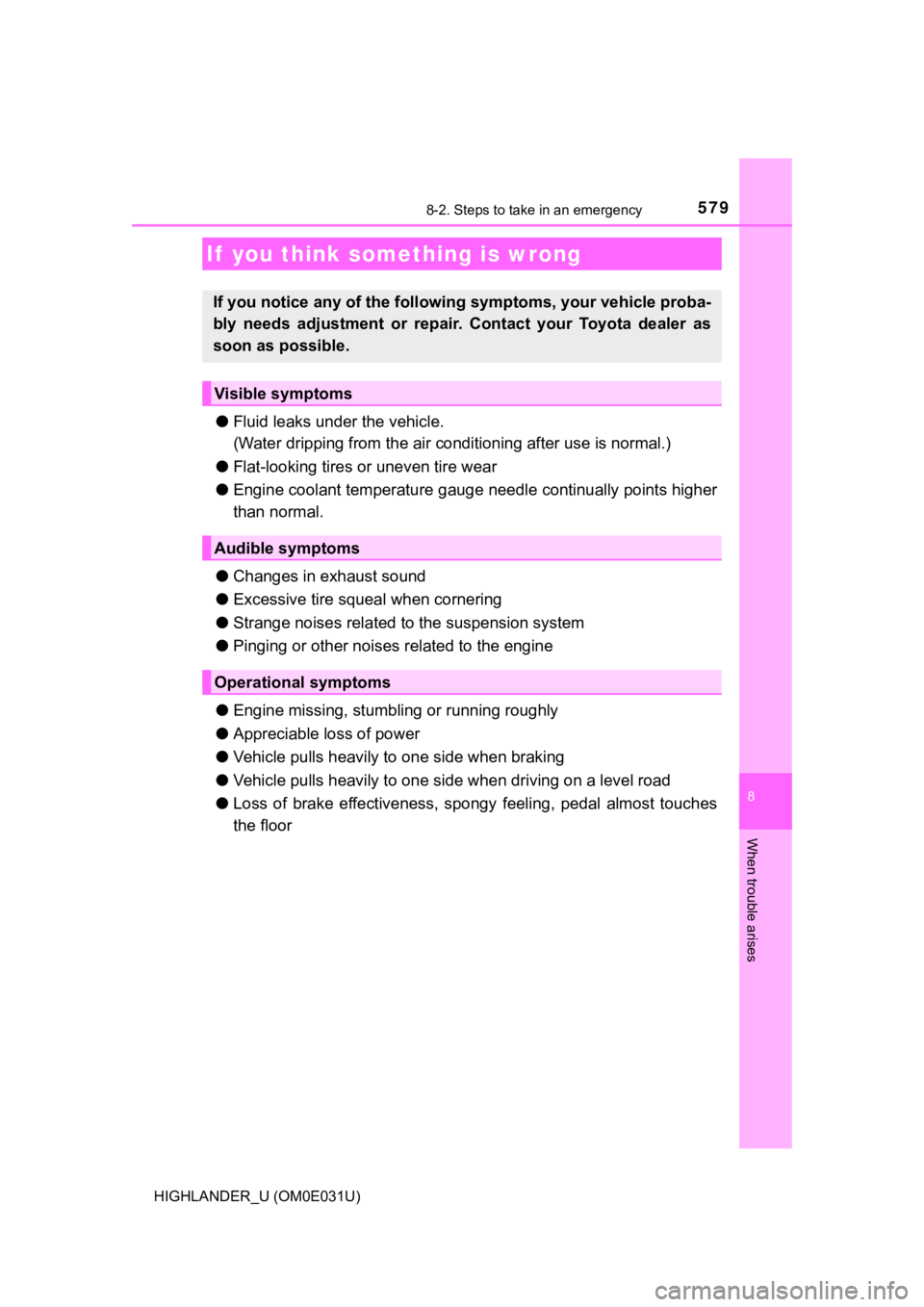
5798-2. Steps to take in an emergency
8
When trouble arises
HIGHLANDER_U (OM0E031U)
●Fluid leaks un der the vehicle.
(Water dripping from the air conditioning a fter use is normal.)
● Flat-looking tires or uneven tire wear
● Engine coolant temperature gauge needle continually points high er
than normal.
● Changes in exhaust sound
● Excessive tire squeal when cornering
● Strange noises related to the suspension system
● Pinging or other noises related to the engine
● Engine missing, stumb ling or running roughly
● Appreciable loss of power
● Vehicle pulls heavily to one side when braking
● Vehicle pulls heavily to one s ide when driving on a level road
● Loss of brake effectiveness, spongy feeling, pedal almost touch es
the floor
If you think something is wrong
If you notice any of the followi ng symptoms, your vehicle proba -
bly needs adjustment or repair. Contact your Toyota dealer as
soon as possible.
Visible symptoms
Audible symptoms
Operational symptoms
Page 595 of 732
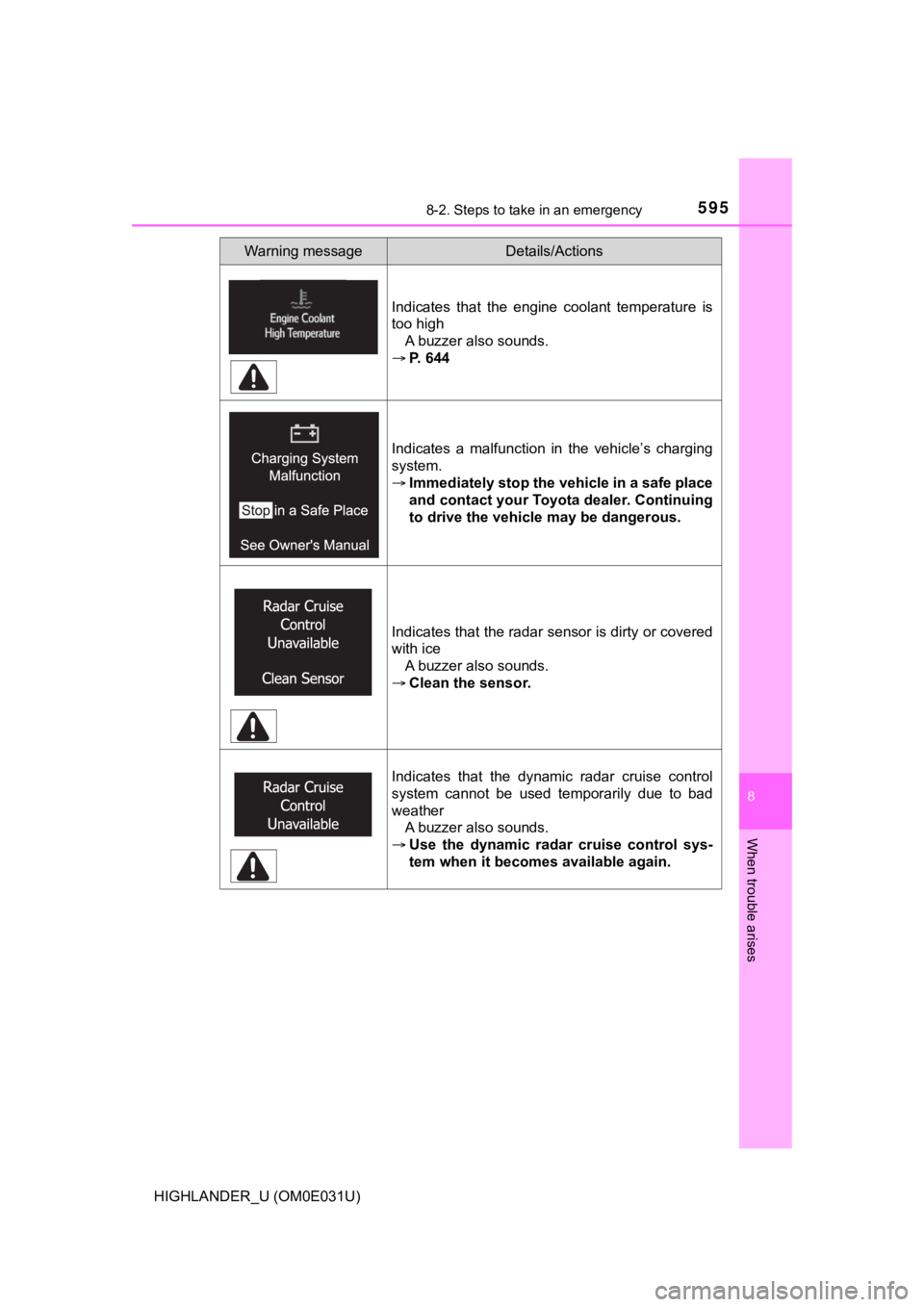
5958-2. Steps to take in an emergency
8
When trouble arises
HIGHLANDER_U (OM0E031U)
Indicates that the engine coolant temperature is
too highA buzzer also sounds.
P. 644
Indicates a malfunction in the vehicle’s charging
system.
Immediately stop the vehicle in a safe place
and contact your Toyota dealer. Continuing
to drive the vehicle may be dangerous.
Indicates that the radar sensor is dirty or covered
with ice
A buzzer also sounds.
Clean the sensor.
Indicates that the dynamic radar cruise control
system cannot be used temporarily due to bad
weather
A buzzer also sounds.
Use the dynamic radar cruise control sys-
tem when it becomes available again.
Warning messageDetails/Actions
Page 644 of 732
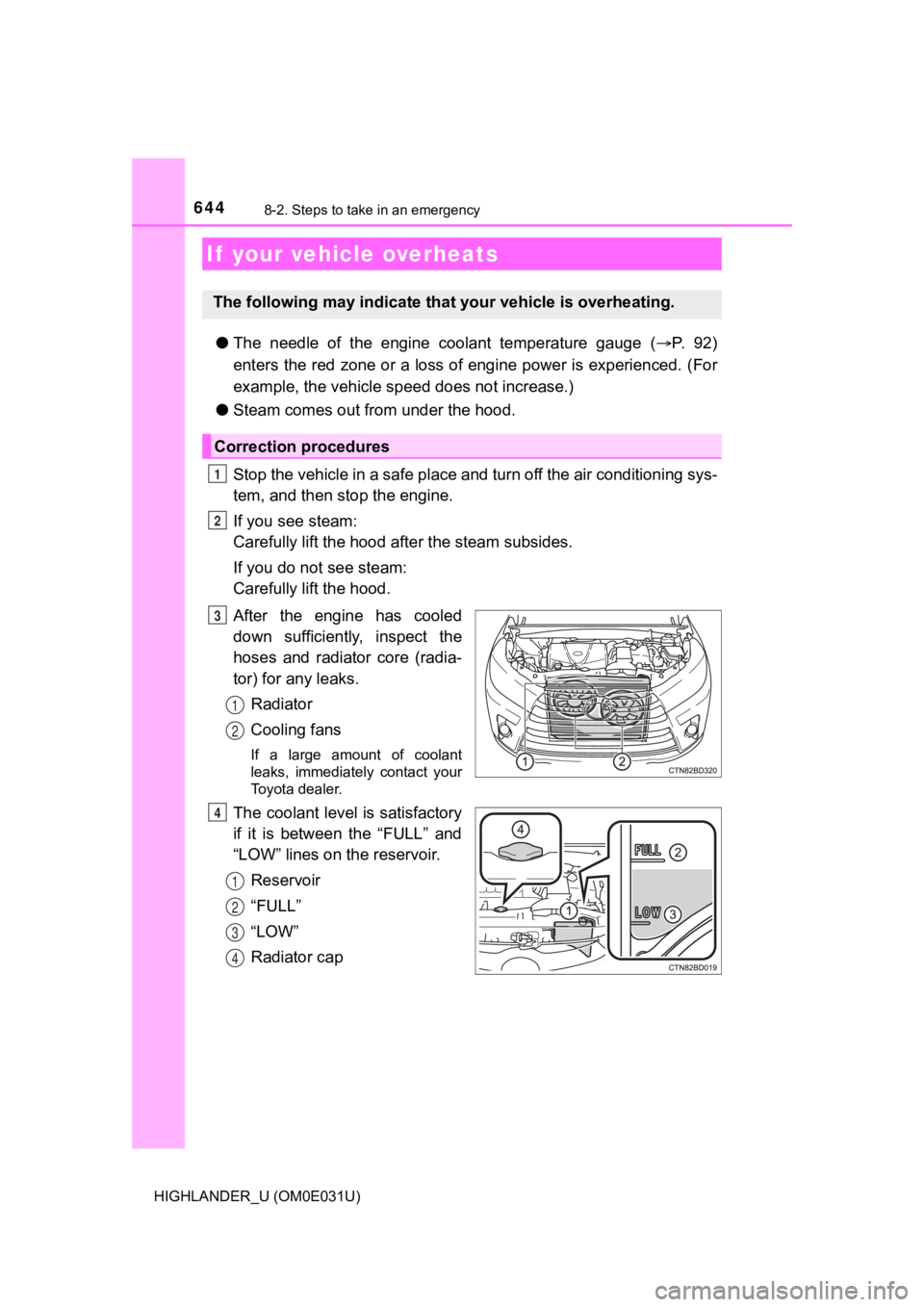
6448-2. Steps to take in an emergency
HIGHLANDER_U (OM0E031U)
●The needle of the engine coolant temperature gauge ( P. 9 2 )
enters the red zone or a loss of engine power is experienced. ( For
example, the vehicle speed does not increase.)
● Steam comes out f rom under the hood.
Stop the vehicle in a safe place and turn off the air condition ing sys-
tem, and then stop the engine.
If you see steam:
Carefully lift the hood after the steam subsides.
If you do not see steam:
Carefully lift the hood.
After the engine has cooled
down sufficiently, inspect the
hoses and radiator core (radia-
tor) for any leaks. Radiator
Cooling fans
If a large amount of coolant
leaks, immediately contact your
Toyota dealer.
The coolant level is satisfactory
if it is between the “FULL” and
“LOW” lines on the reservoir.Reservoir
“FULL”
“LOW”
Radiator cap
If your vehicle overheats
The following may indicate that your vehicle is overheating.
Correction procedures
1
2
3
1
2
4
1
2
3
4
Page 645 of 732
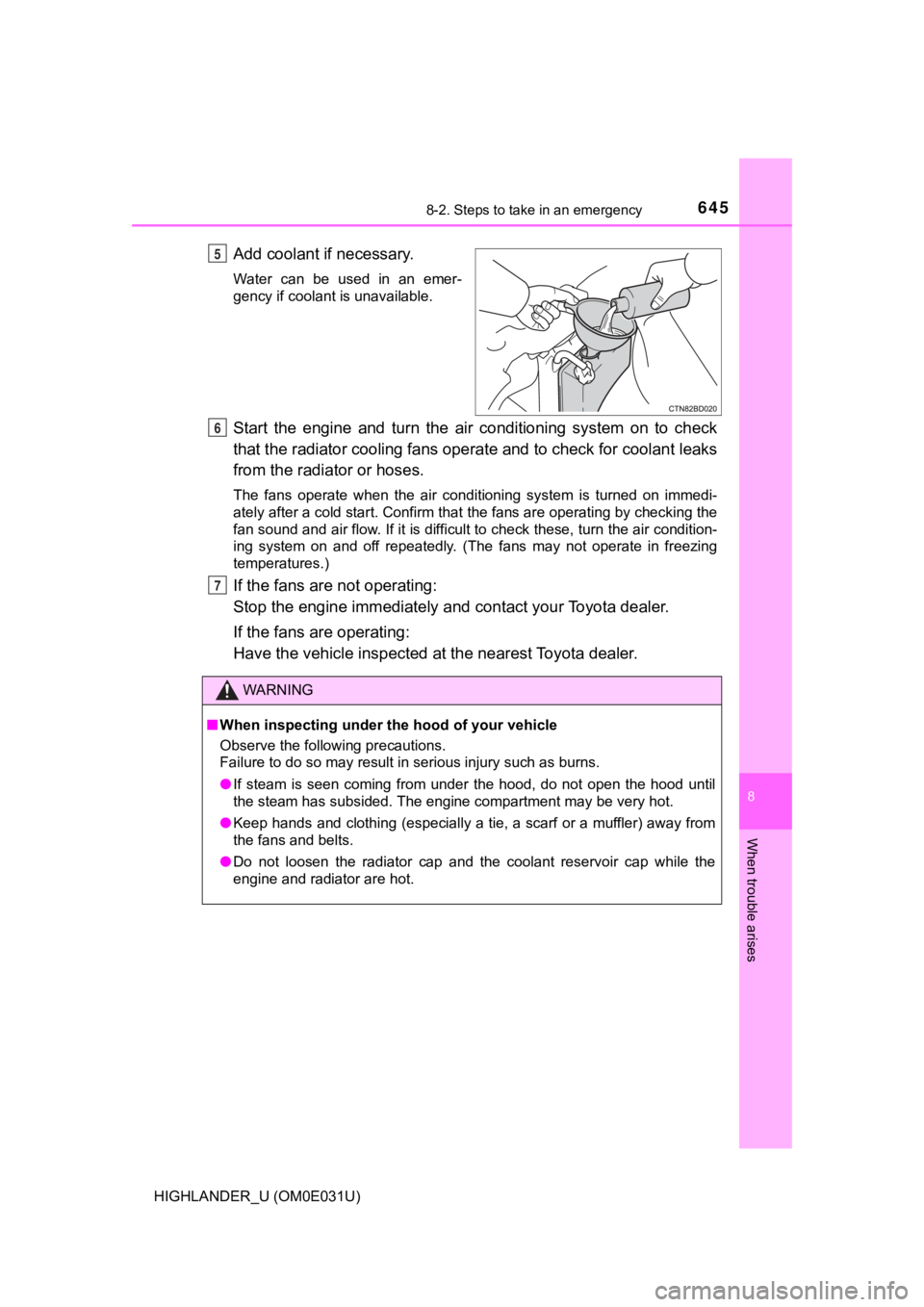
6458-2. Steps to take in an emergency
8
When trouble arises
HIGHLANDER_U (OM0E031U)
Add coolant if necessary.
Water can be used in an emer-
gency if coolant is unavailable.
Start the engine and turn the air conditioning system on to check
that the radiator cooling fans operate and to check for coolant leaks
from the radiator or hoses.
The fans operate when the air conditioning system is turned on immedi-
ately after a cold start. Confirm that the fans are operating b y checking the
fan sound and air flow. If it is difficult to check these, turn the air condition-
ing system on and off repeatedly. (The fans may not operate in freezing
temperatures.)
If the fans are not operating:
Stop the engine immediately and contact your Toyota dealer.
If the fans are operating:
Have the vehicle ins pected at the nearest Toyota dealer.
5
WARNING
■When inspecting under th e hood of your vehicle
Observe the following precautions.
Failure to do so may result in serious injury such as burns.
● If steam is seen coming from under the hood, do not open the ho od until
the steam has subsided. The engine compartment may be very hot.
● Keep hands and clothing (especially a tie, a scarf or a muffler ) away from
the fans and belts.
● Do not loosen the radiator cap and the coolant reservoir cap wh ile the
engine and radiator are hot.
6
7
Page 719 of 732
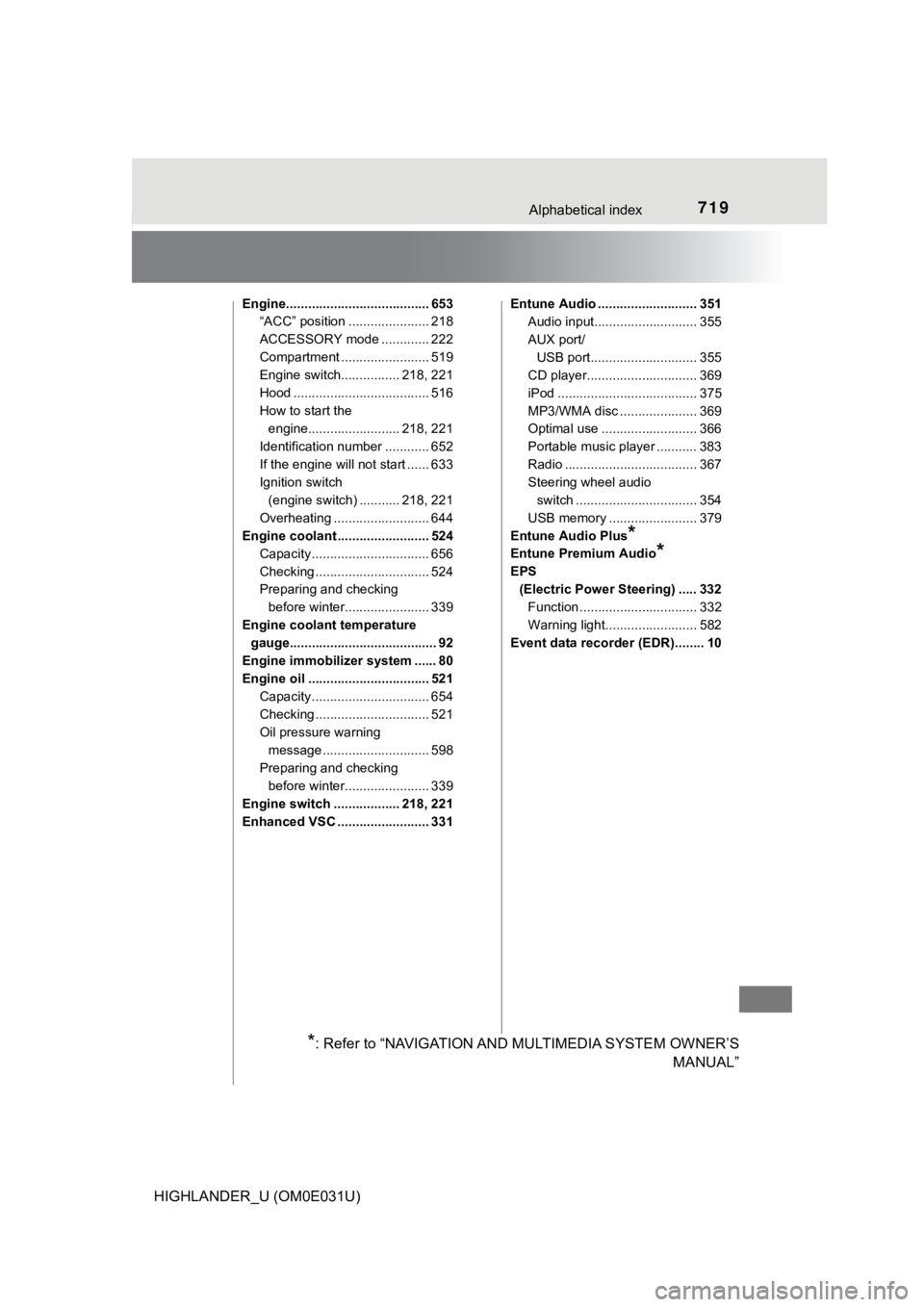
719Alphabetical index
HIGHLANDER_U (OM0E031U)
Engine....................................... 653“ACC” position ...................... 218
ACCESSORY mode ............. 222
Compartment ........................ 519
Engine switch................ 218, 221
Hood ..................................... 516
How to start the engine......................... 218, 221
Identification number ............ 652
If the engine will not start ...... 633
Ignition switch (engine switch) ........... 218, 221
Overheating .......................... 644
Engine coolant ......................... 524
Capacity ................................ 656
Checking ............................... 524
Preparing and checking before winter....................... 339
Engine coolant temperature gauge........................................ 92
Engine immobilizer system ...... 80
Engine oil ................................. 521 Capacity ................................ 654
Checking ............................... 521
Oil pressure warning
message ............................. 598
Preparing and checking
before winter....................... 339
Engine switch .................. 218, 221
Enhanced VSC ......................... 331 Entune Audio ........................... 351
Audio input............................ 355
AUX port/
USB port............................. 355
CD player.............................. 369
iPod ...................................... 375
MP3/WMA disc ..................... 369
Optimal use .......................... 366
Portable music player ........... 383
Radio .................................... 367
Steering wheel audio
switch ................................. 354
USB memory ........................ 379
Entune Audio Plus
*
Entune Premium Audio*
EPS (Electric Power Steering) ..... 332
Function ................................ 332
Warning light......................... 582
Event data recorder (EDR)........ 10
*: Refer to “NAVIGATION AND MULTIMEDIA SYSTEM OWNER’S MANUAL”